Archive
Ephemeris: 04/15/2024 – How the Ancient Greeks tried to measure the distance to the Sun
This is Bob Moler with Ephemeris for Monday, April 15th. Today the Sun will be up for 13 hours and 31 minutes, setting at 8:28, and it will rise tomorrow at 6:55. The Moon, at first quarter today, will set at 4:15 tomorrow morning.
The first quarter Moon tonight reminds me of how the Greeks used the quarter Moon to attempt to determine the distance to the Sun. The idea was to determine when the Moon was exactly at first or last quarter, so the angle of the Sun-Moon-Earth was exactly 90°. The next thing to do was to measure the actual angle between the Sun and the Moon at that instant. It’s a difficult observation. Aristarchus tried and got a result that the Sun was about 19 times the distance of the Moon. The Sun-Earth-Moon angle he got was 87°. Hipparchus measured the Moon to be 60 earth radii away which is near the Moon’s actual distance from the Earth. In actuality the Sun is about 400 times the distance to the Moon.
The astronomical event times given are for the Traverse City/Interlochen area of Michigan (EDT, UT–4 hours). They may be different for your location.
Addendum
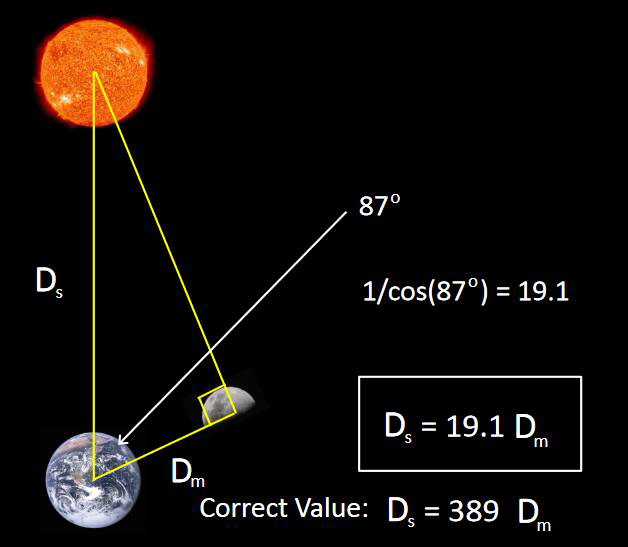
Ephemeris: 04/12/2024 – GTAS Meeting tonight: Hidden Figures
This is Ephemeris for Friday, April 12th. Today the Sun will be up for 13 hours and 22 minutes, setting at 8:24, and it will rise tomorrow at 7:01. The Moon, 3 days before first quarter, will set at 1:52 tomorrow morning.
Tonight’s meeting of the Grand Traverse Astronomical Society at 8 pm, at Northwestern Michigan College’s Rogers Observatory, will feature the student astronomy group’s movie night with a presentation of Hidden Figures. How female African American “Computers”, made the space program possible. Many of NASA’s facilities were in the segregated South. Back then computers were also people with tremendous math skills, who could work out problems of orbital mechanics by hand and with mechanical calculators. Plus we’ll see if anyone has made it back to report on Monday’s total solar eclipse. The observatory is located south of Traverse City on Birmley Road between Garfield and Keystone roads.
The astronomical event times given are for the Traverse City/Interlochen area of Michigan (EDT, UT–4 hours). They may be different for your location.
Addendum
Ephemeris: 04/11/2024 – What is the far side of the Moon good for?
This is Ephemeris for Thursday, April 11th. Today the Sun will be up for 13 hours and 19 minutes, setting at 8:23, and it will rise tomorrow at 7:02. The Moon, 3 days past new, will set at 12:40 tomorrow morning.
The Last Monday when we were having an eclipse of the Sun, the far side of the Moon was fully illuminated. So it can’t possibly be the dark side of the Moon, not permanently. The dark side of the Moon is the night side and Monday that was the side facing the Earth. But what’s the far side of the Moon good for? The Chinese seem to be very interested in it. They have a lander and a rover on the far side, and they’re going to go back and grab a sample from the far side and bring it back to the Earth. The far side of the Moon is one place in the whole solar system in which the cacophony of radio signals from the Earth cannot be heard so it’s a great place to set up a radio telescope. The craters on the far side of the moon might be used to place a dish antenna.
The astronomical event times given are for the Traverse City/Interlochen area of Michigan (EDT, UT–4 hours). They may be different for your location.
Addendum
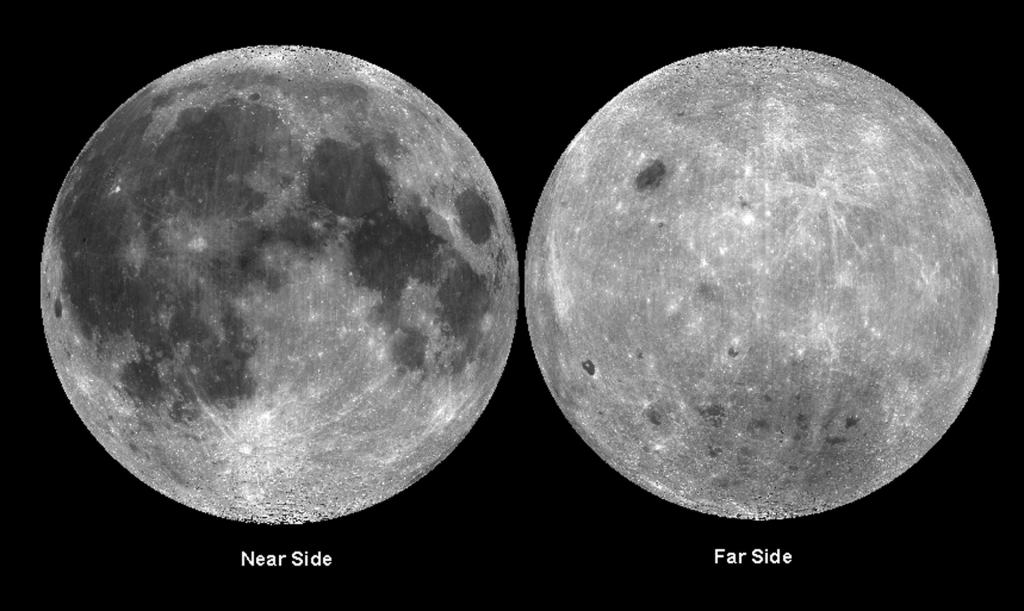
Ephemeris: 04/10/2024 – Where have the naked-eye planets wandered off to?
This post was updated due to it being uploaded late, and without illustrations. This was due to my recovery from the mad dash eclipse trip Sunday through Tuesday. By the way it was glorious! I shall recount it soon in an Ephemeris Extra post.
This is Ephemeris for Wednesday, April 10th. Today the Sun will be up for 13 hours and 16 minutes, setting at 8:22, and it will rise tomorrow at 7:04. The Moon, 2 days past new, will set at 11:21 this evening.
Let’s find out where the naked-eye planets have wandered off to this week, and see what planets are left. Bright Jupiter is low and in the west, and tonight only can be seen below the crescent Moon. It will set at 10:25 pm. We are getting close to losing Jupiter in the evening sky. Comet 12P/Pons-Brooks is just below-right of it. Though officially naked-eye brightness, one has to have very good eyes, binoculars or telescope to spot it. In my Wednesday blog posts at bobmoler.wordpress.com I have finder charts. In the morning Mars, and Saturn will be very close together in the east southeastern sky at 6:30. They will be fighting the bright morning twilight and low altitude then.
The astronomical event times given are for the Traverse City/Interlochen area of Michigan (EDT, UT–4 hours). They may be different for your location.
Addendum






Ephemeris: 04/09/24 – When is the next solar eclipse?
This is Ephemeris for Tuesday, April 9th. Today the Sun will be up for 13 hours and 13 minutes, setting at 8:21, and it will rise tomorrow at 7:06. The Moon, 1 day past new, will set at 9:58 this evening.
I hope you’ve had a good eclipse and were able to view it. I don’t know if you saw the eclipse or if I saw the eclipse since this is being recorded before the events. However, it’s time to look at the next time you might be able to see a solar eclipse. Our next Great American Eclipse isn’t for 21 years on August 12th 2045, which I won’t make, guaranteed. But we have some other minor solar eclipses visible in our area before that eclipse. Our next eclipse will be about 11% eclipse that’ll occur August 12th of 2026, just two years away. It’s not much compared to the 89% yesterday for our area. There will be an even tinier eclipse on January 26th of 2028. Just 2.5% of the Sun’s diameter will be covered. The best of the next three eclipses occurs on January 14th 2029, when the Moon encroaches on 69% of the Sun’s diameter. There are five more partial eclipses visible before 2045.
The astronomical event times given are for the Traverse City/Interlochen area of Michigan (EDT, UT–4 hours). They may be different for your location.
Addendum

Ephemeris: 04/08/2024 – Solar Eclipse Today!
This is Ephemeris for Monday, April 8th. Today the Sun will be up for 13 hours and 10 minutes, setting at 8:19, and it will rise tomorrow at 7:08. The Moon is new today, and won’t be visible.
This afternoon there will be a total eclipse of the sun in the United States. But right here it’ll be a very deep partial eclipse, with the moon covering nearly 90% of the sun. For the Grand Traverse Area of Michigan, it will begin at 1:58 PM, mid-eclipse will be at 3:12 PM and the eclipse will end at 4:25 PM. In deep partial eclipses I’ve noticed that the sunlight has a slight yellowish hue. It’s possible effect of the Sun’s edge being cooler than the rest of the disk. Even if it’s cloudy here NASA will broadcast the eclipse from eight points along its route from Texas to Maine. It’s on the Internet on NASA’s YouTube channel, or in an Internet browser type NASA and ECLIPSE. Look for a link for nasa.gov, and you should be able to find out where that feed is. Good Luck!
The astronomical event times given are for the Traverse City/Interlochen area of Michigan (EDT, UT–4 hours). They may be different for your location.
Addendum
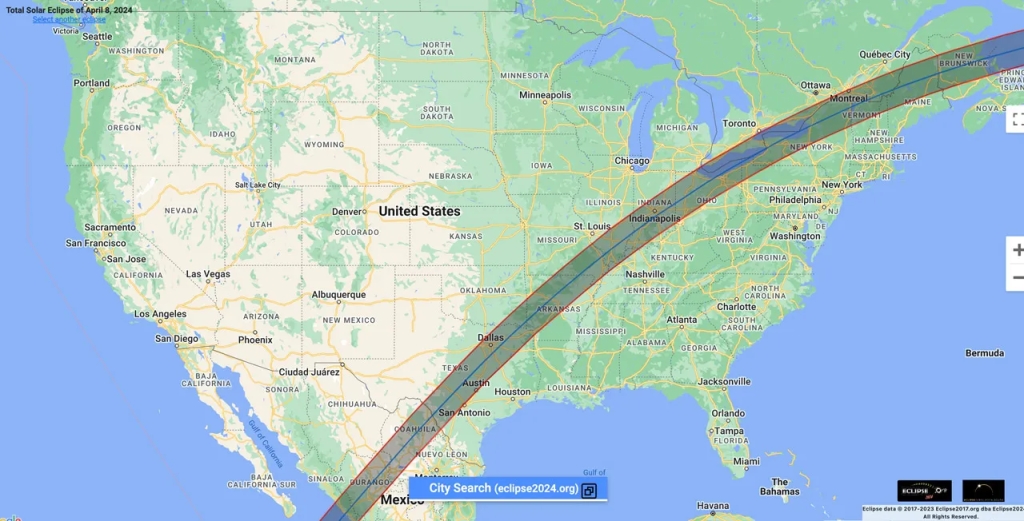
Ephemeris: 04/05/2024 – A ready-made eclipse projector
This is Ephemeris for Friday, April 5th. Today the Sun will be up for 13 hours, setting at 8:16, and it will rise tomorrow at 7:13. The Moon, 3 days before new, will rise at 6:24 tomorrow morning.
One quick and easy way to view next Monday’s eclipse via projection will be to use a calendar. All those little drain holes are actually pinholes, and will allow you to see multiple images of the eclipsed Sun. Multiple suns will be projected on whatever its shadow falls on. So that’s a quick and easy way of doing it. You may want to plug up some of the holes though, or the images might overlap. The eclipse will start for IPR listening area at 1:58 pm give or take a minute or two, mid-eclipse will be around 3:12 pm and the eclipse will end at 4:25 pm. If you’re wearing eclipse glasses the moon will move from lower right to upper left. If you’re using the pinhole projection method the moon will move from the upper right to lower left.
The astronomical event times given are for the Traverse City/Interlochen area of Michigan (EDT, UT–4 hours). They may be different for your location.
Addendum
Ephemeris: 04/04/2024 – Viewing the eclipse with pinhole projection.
This is Bob Moler with Ephemeris for Thursday, April 4th. Today the Sun will be up for 12 hours and 57 minutes, setting at 8:14, and it will rise tomorrow at 7:15. The Moon, 3 days past last quarter, will rise at 6:01 tomorrow morning.
If you have eclipse glasses and even if you don’t a good way perhaps the best way to view the solar eclipse is to use projection specifically pinhole projection the pinhole can act like a lens and with something as bright as the sun can cast a good visible image of the sun. Probably the best way to do it is to find a long box and cut a hole in one end. Have one long side open or partially open to view the Sun’s projected image. Cover the hole with aluminum foil and then make pinholes of various sizes, about half inch apart. The bigger the pinhole the brighter the Sun’s image but also the fuzzier it will be. The smaller the hole the sharper and dimmer the sun will be. For the IPR listening area the eclipse will start around 1:58 pm, and end around 4:25 pm.
The astronomical event times given are for the Traverse City/Interlochen area of Michigan (EDT, UT–4 hours). They may be different for your location.
Addendum
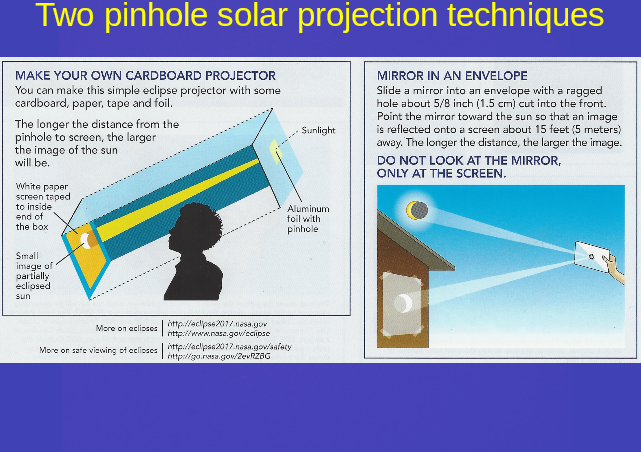
A long box can be used to project the image inside. The diameter of the pin hole is a compromise between sharpness and brightness of the image.
…The farther the image is projected the larger it is.
The throw of the image can be increased by using a mirror masked with a quarter of a inch or larger hole and sending the image 10 or more feet away.
Ephemeris: 04/03/2024 – Where have the naked-eye planets wandered off to this week?
This is Ephemeris for Wednesday, April 3rd. Today the Sun will be up for 12 hours and 54 minutes, setting at 8:13, and it will rise tomorrow at 7:17. The Moon, 2 days past last quarter, will rise at 5:33 tomorrow morning.
Let’s find out where the naked-eye planets have wandered off to this week, and see what planets are left. Mercury is now too close to the Sun to be spotted. Bright Jupiter is due west at 8:45 pm or a half hour after sunset. It will set at 11:05 pm. We are getting close to losing Jupiter in the evening sky. Comet 12P/Pons-Brooks is right of and a bit below Jupiter in the evening. Though officially naked-eye brightness, one has to have very good eyes, binoculars or telescope to spot it. In my Wednesday blog posts at bobmoler.wordpress.com I have finder charts. In the morning Mars, and especially Venus and Saturn may be impossible to spot, in the east-southeast in the bright twilight. Mars will rise at 6:10, and will be very low in the east-southeast at 6:45 am.
The astronomical event times given are for the Traverse City/Interlochen area of Michigan (EDT, UT–4 hours). They may be different for your location.
Addendum


During the solar eclipse on the 8th, during totality, the comet will be located around the 2nd to the last position of its track. However, unless it is obviously noticeable, totality time is too short to use trying to find it. Enjoy the glory of the sun’s corona for the brief time you have.
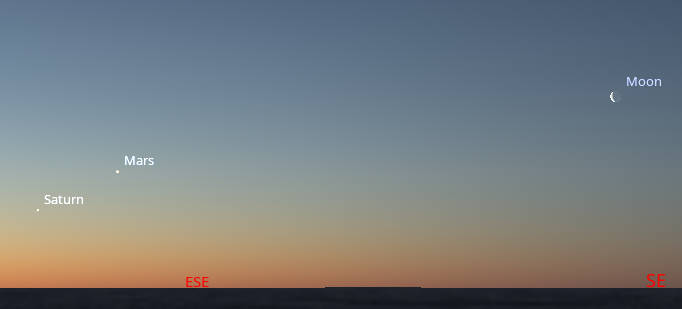



Ephemeris: 04/02/2024 – Availability of and checking out eclipse glasses
This is Ephemeris for Tuesday, April 2nd. Today the Sun will be up for 12 hours and 51 minutes, setting at 8:12, and it will rise tomorrow at 7:18. The Moon, 1 day past last quarter, will rise at 4:59 tomorrow morning.
In six days there will be a total solar eclipse, if you’re right place. Northern Michigan is not the right place. We get a pretty good chunk of the Sun being covered by the Moon, about nearly 90% around here. This means that you will still need protection if you want to view the eclipse. My daughter reports that there are places around Traverse City that you can get solar eclipse glasses. However, to make sure that they are the proper eclipse glasses they will have a globe symbol with ISO in it for the International Organization for Standardization. Also, they must state that they conform to and meet the transmission requirements of ISO 12312-2, filters for direct observation of the sun. That doesn’t keep someone from making counterfeit ones. A way to check is with laying one lens onto a smartphone flashlight, which should be barely visible through it.
The astronomical event times given are for the Traverse City/Interlochen area of Michigan (EDT, UT–4 hours). They may be different for your location.
Addendum








